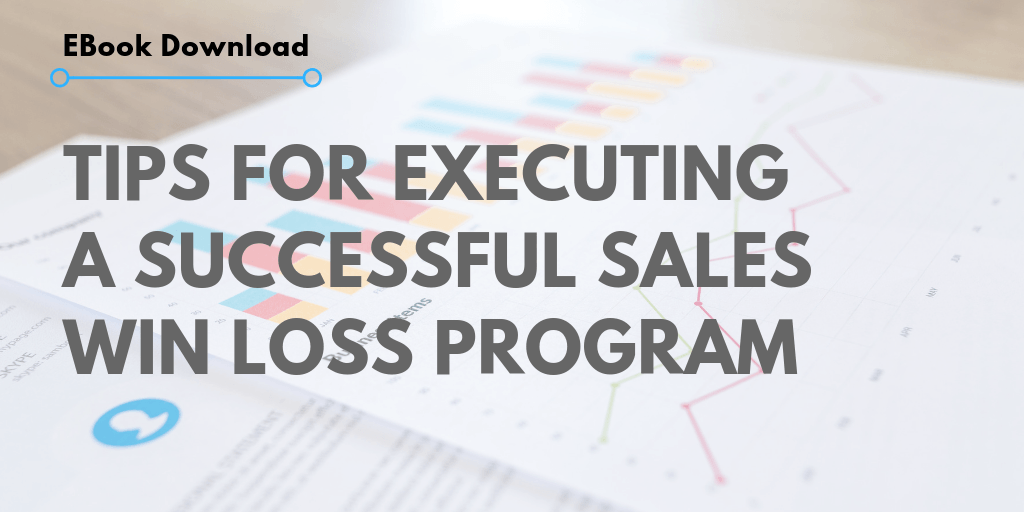In parts 1, 2 and 3 of this series on Sales Win Loss Programs, I focused on why collecting feedback after a sales pitch is so valuable, the different ways it can be gleaned, and best practices for conducting post-sale interviews. In this fourth and final installment, I will share what you should do with all the valuable insights uncovered, and how you can quantify the return on investment of your efforts.
Key Steps for Executing a Sales Win Loss Program
At this point (if you’ve read our previous posts) in your Sales Win Loss program, we assume you have:
- Identified your objectives for the Sales Win Loss program
- Secured buy-in from key stakeholders
- Determined which wins and losses to focus on
- Developed your interview questionnaire
- Scheduled your first interview with key decision maker
- Prepped for the Sales Win Loss call
Next up – making the call.
Let’s say you conducted the first call with a company that evaluated your offering but ultimately chose a competitor, and the interview went well. You learned a tremendous amount about the prospect’s decision-making process, how your company was perceived, how your offering compares to your primary competitors, how the sales team performed, and you identified several primary and secondary decision drivers. Now what?
Review and Share Sales Win Loss Data
The first thing you’ll want to do is summarize your findings. At Satrix, we deliver a report to our clients after each interview, with the complete call transcript and a summary of key findings.
There are many effective ways you can present the important takeaways, but one we’ve found that resonates is to present the summary in the form of a SWOT Analysis. This enables our clients to quickly review the strengths, weaknesses, opportunities and threats we identified from the interview.
The report should be shared with everyone in the company who could benefit from the insights, including sales, marketing, product, operations, customer success, the c-suite, etc.
Collectively Look for Patterns and Trends from Decision Makers
We also recommend that, after reviewing each report, the leadership team set time aside for a post-mortem. It is during these huddles when the team can diagnose the problems and identify specific actions that should be taken to increase the likelihood of winning a similar deal in the future.
While it happens on occasion, it’s rare that a single interview reveals an obvious improvement opportunity. Sure, curiosity will be satisfied. You will hear some interesting things about your competition, and you’ll gain insight into the purchase considerations of your ideal customers.
However, the power of a Sales Win Loss Program becomes more apparent over time. After just a handful of completed interviews, patterns will start to emerge. After a dozen or so, your organization is likely to have massive amounts of qualitative feedback that, when properly mined, will serve as a blueprint for sales improvement.
Continuous Learning = Continuous Improvement
The final step, of course, is to rally the organization to act – to reinforce and replicate behaviors that often lead to success and address the issues that tend to result in failure.
After conducting thousands of interviews on behalf of our clients, something that continues to surprise us is how many of the themes we identify are entirely in the company’s control, and therefore relatively easy to fix.
All too often, drivers of lost sales involve issues such as: poor sales team responsiveness, a perceived lack of product knowledge, a product demo that isn’t customized to the needs of the prospect, a poorly run pitch meeting, supplying references of existing customers who are not that enthused, just to name a few.
Identifying the ‘low-hanging fruit’ improvement opportunities can drive a meaningful return on investment (ROI) in just a few months.
Defining Success for Your Sales Win Loss Program
What does ROI look like?
Of course, the chief reason for launching a Sales Win Loss Program is to improve sales win rates. Most Sales Win Loss endeavors will rightfully point back to that metric as their key measure of success. However, there are many other quantitative and qualitative measures you can look to for evidence your program is paying off, some of which include:
- Number of wins or losses vs your main competitor(s)
- Wins or losses by lead source
- Average deal size
- Percentage of opportunities that make it to a specific stage in the sales process (i.e. beyond the RFI, RFP, demo, finalists in contention, etc.)
- Sales success in a new region, market, product, etc.
- Average length of sales cycle
- Greater clarity on how you are found by prospects
- Greater clarity on the perceived strengths and weaknesses of your offering / company
- Greater clarity on sales team performance
- Greater clarity on which aspects of your messaging resonates vs falls flat
With all this newfound knowledge and data now at your fingertips, your organization will be in the enviable position of using data and facts to guide your decision making.
As has been said any number of times – sales is a numbers game. So, don’t rely on suspicion, feel, anecdotal information, or incomplete feedback to drive higher sales win rates. Institute a strong, scientific, methodologically sound Sales Win Loss Program, and reap the benefits.
Let’s Talk About Your Sales Win Rates. Contact Us Today.


